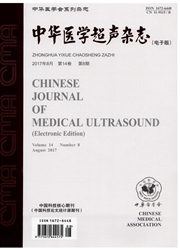

 中文摘要:
中文摘要:
目的应用剪切波弹性成像技术定量测量乳腺非肿块型病变的弹性模量值,评价该技术在乳腺非肿块型病变诊断中的价值。方法 2008年5月至2011年10月,在解放军总医院超声诊断科行超声检查并经手术或穿刺活检病理证实的非肿块型病变80例。对80个乳腺非肿块型病变进行实时剪切波弹性成像检查,获得乳腺病灶的弹性模量参数,分析比较乳腺良恶性非肿块型病变剪切波弹性参数的差异,确定弹性模量在乳腺非肿块型病变诊断中的准确性、敏感度和特异度。结果 80个乳腺非肿块型病变中,病理诊断恶性37例(46%),良性43例(54%),恶性非肿块型病变的最大、平均弹性模量值分别为(106.28±46.39)kPa和(51.02±30.06)kPa;良性非肿块型病变的最大、平均弹性模量值分别为(37.13±18.22)kPa和(26.44±15.62)kPa,良恶性病灶间的最大弹性值和平均值差异均有统计学意义(t=15.328、18.149,P均〈0.05)。分别以弹性模量最大值61.25 kPa和平均值40.65 kPa作为诊断阈值时,诊断的准确性、敏感度、特异度分别为70.53%、66.83%、51.22%和68.34%、65.81%、50.63%。将常规超声与弹性模量最大值相结合,则诊断的准确性、敏感度、特异度分别为84.17%、92.28%、68.39%,诊断的准确性和特异度较常规超声相比显著提高(χ^2=5.217、9.652,P均〈0.05)。将常规超声与弹性模量平均值相结合,则诊断的准确性、敏感度、特异度分别为82.35%、90.66%、63.35%,诊断的准确性和特异度较常规超声相比显著提高(χ^2=5.084、8.686,P均〈0.05)。结论弹性成像单独应用于非肿块型乳腺病变的诊断准确性和特异度并不高,但其与常规超声相结合,可显著提高非肿块型乳腺病变超声诊断的准确性和特异度,具有重要的临床意义。
 英文摘要:
英文摘要:
Objective To obtain the elasticity value of non-mass-like breast lesions with supersonic shear wave elastrography(SWE), in order to observe the value of quantitative elastography with SWE in differential diagnosis of non-mass-like breast lesions. Methods SWE was performed in 80 non-mass-like breast lesions. Taking pathologic results as reference, quantitative elasticity value of the lesions were performed. The diagnostic accuracy, sensitivity and specificity were calculated. Results In the 80 non-mass-like breast lesions, 37 lesions(46%) were malignant and 43 lesions(54%) were benign. The max and mean elasticity value of malignant lesions were(106.28±46.39) kPa and(51.02±30.06) kPa, and the max and mean elasticity value of benign lesions were(37.13±18.22) kPa and(26.44±15.62) kPa. There was statistical differences between malignant and benign lesions in max and mean elasticity values(t=15.328, 18.149, both P0.05). Taking 61.25 kPa as the threshold of max elasticity value and 40.65 kPa as the threshold of mean elasticity value, the diagnostic accuracy, sensitivity and specificity were 70.53%, 66.83%, 51.22% and 68.34%, 65.81%, 50.63%, respectively. When max elasticity was combined with conventional ultrasound(US), the diagnostic accuracy, sensitivity and specificity were 84.17%, 92.28% and 68.39%, respectively. The diagnostic accuracy and specificity significantly increased compared with conventional US(χ^2=5.217, 9.652, both P0.05). When mean elasticity was combined with conventional US, the diagnostic accuracy, sensitivity and specificity were 82.35%, 90.66%, and 63.35%, respectively. The diagnostic accuracy and specificity significantly increased compared with conventional US(χ^2=5.084, 8.686, both P0.05). Conclusions The diagnostic accuracy and specificity of SWE for non-mass-like breast lesions are not high. But when SWE is combined with conventional US, the diagnostic accuracy and specificity increase significantly, which is very helpful for the diagnostic of
 同期刊论文项目
同期刊论文项目
 同项目期刊论文
同项目期刊论文
 期刊信息
期刊信息
